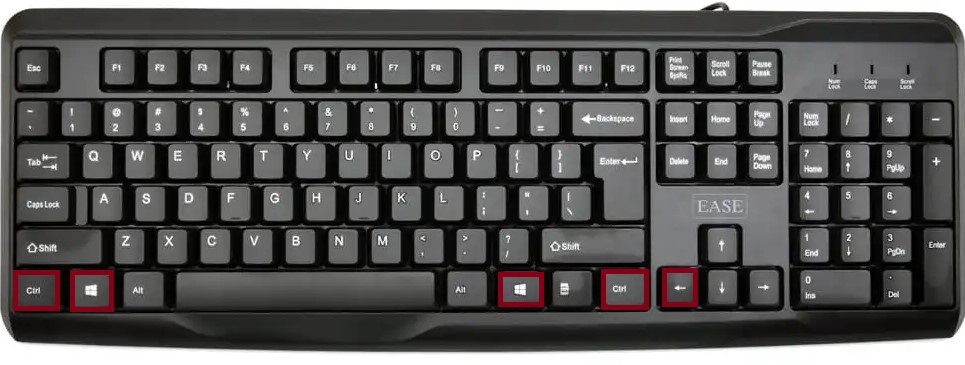The Windows + Ctrl + LeftArrow keyboard shortcut is a powerful navigation tool built into Windows 10 and Windows 11. It allows users to instantly switch to the virtual desktop located to the left of their current workspace. Virtual desktops are one of Windows’ most under utilized productivity features, giving users the ability to organize tasks, apps, and projects across multiple desktop environments without needing extra monitors.
For professionals, students, gamers, and multitaskers, this shortcut (Windows+Ctrl+Leftarrow) eliminates the need to reach for the mouse or use the Task View panel repeatedly. Instead, with one quick keystroke, you can jump directly into another workspace, helping you maintain focus and minimize clutter.
Table of Contents
Function in Windows Operating System
In the Windows environment, pressing Windows+Ctrl+LeftArrow performs the following:
- Switches to the virtual desktop on the left of the one you are currently using.
- If there is no desktop to the left, the command simply does nothing.
- Works hand-in-hand with:
- Windows + Ctrl + D → Creates a new virtual desktop.
- Windows + Ctrl + F4 → Closes the current virtual desktop.
- Windows + Ctrl + Right Arrow → Moves to the desktop on the right.

This set of shortcuts is part of the Windows Virtual Desktop System, which is designed to give users multiple workspaces for organization, efficiency, and focus.
Use of Windows+Ctrl+LeftArrow in Microsoft Applications
Although Windows + Ctrl + Left Arrow is a system-level shortcut rather than an app-specific one, its benefits extend directly into how you use Microsoft applications by keeping them neatly organized across desktops. For example:
- Microsoft Word, Excel, and PowerPoint – You can keep reports, data sheets, and presentations in one desktop, while dedicating another desktop to your research or supporting documents. Switching between them avoids desktop clutter.
- Microsoft Outlook – Keep your email client open on a separate desktop so it doesn’t distract you while you are working on core tasks.
- Microsoft Edge – Separate browsing tabs for research and entertainment by keeping them on different desktops.
- Microsoft Teams – Place Teams or other communication apps on one desktop while keeping your main work environment clean.
Because the shortcut is managed by Windows, it overrides in-app shortcuts if pressed, ensuring consistent behavior across all Microsoft tools.
Use in Other Applications
The advantages of this shortcut extend far beyond Microsoft apps. It helps keep third-party software neatly managed across workspaces:
- Web Browsers (Chrome, Firefox, Opera, etc.) – Keep personal browsing separate from work browsing by assigning each to a different desktop.
- Creative Design Tools (Photoshop, Illustrator, AutoCAD) – Place heavy design work on one desktop while keeping file references or tutorials open on another.
- Gaming – Gamers can run a game on one desktop and keep a walkthrough, chat app, or streaming software on another for easy switching.
- Development Tools – Developers often prefer separating coding environments (IDE on one desktop) and testing tools (browsers, emulators, or consoles) on another.
Practical Scenarios
Here are some common situations where Windows + Ctrl + Left Arrow is particularly useful:
- Work vs. Personal Separation – Keep professional apps on one desktop and personal messaging apps like WhatsApp or Discord on another.
- Project-Specific Workflows – Assign each desktop to a project, such as Desktop 1 for research, Desktop 2 for writing, and Desktop 3 for presentations.
- Reducing Distractions – Move distracting apps like social media to a separate desktop and only switch to them during breaks.
- Multi-Monitor Alternative – Even if you don’t own multiple screens, virtual desktops give you the same organizational benefits.
Mac Equivalent
On macOS, Apple provides a similar feature called Spaces. The equivalent shortcut is:
- Control + Left Arrow → Switches to the desktop space immediately to the left.
This works almost identically to Windows’ implementation, allowing Mac users to navigate between work spaces quickly.
FAQs
If Windows + Ctrl + Left Arrow doesn’t work as expected, here are some common causes:
- No Virtual Desktops Created – You need more than one desktop for the shortcut to function. Use Windows + Ctrl + D to create one.
- Disabled Task View – If Task View has been disabled via system settings or group policy, shortcuts may fail.
- Conflicting Shortcuts – Some gaming overlays or third-party programs may override the combination.
- Outdated Windows Version – This shortcut is supported only on Windows 10 and Windows 11. Update if you’re using an older OS.
- Hardware Issues – Ensure your Windows, Ctrl, and arrow keys are working correctly.
Summary Table
| Shortcut | Action | OS Requirement |
|---|---|---|
| Windows + Ctrl + Left Arrow | Switch to the desktop on the left | Windows 10/11 |
| Windows + Ctrl + D | Create a new virtual desktop | Windows 10/11 |
| Windows + Ctrl + F4 | Close the current desktop | Windows 10/11 |
| Windows + Ctrl + Right Arrow | Switch to the desktop on the right | Windows 10/11 |
Final Thoughts
The Windows+Ctrl+LeftArrow shortcut may seem small, but it has a big impact on productivity. By letting you navigate between virtual desktops instantly, it helps you maintain focus, avoid clutter, and structure your digital workspace to match your workflow.
Whether you’re a student juggling assignments, a professional managing multiple projects, or a gamer keeping entertainment separate from work, this shortcut ensures smooth transitions between tasks. When used alongside its companion shortcuts (Windows + Ctrl + D, Windows + Ctrl + F4, and Windows + Ctrl + Right Arrow), it unlocks the full power of virtual desktops in Windows.